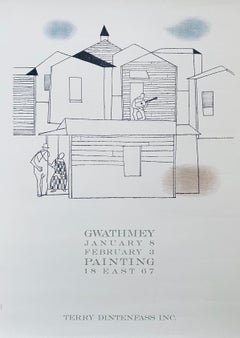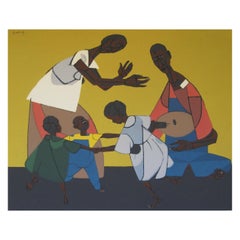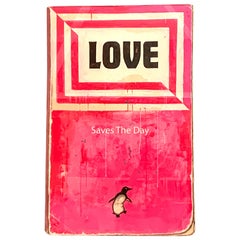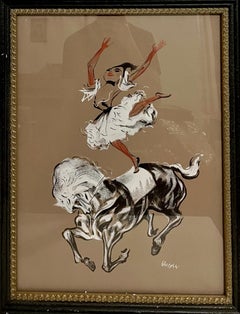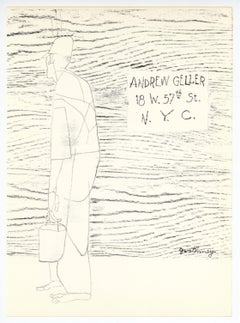"Love Saves The Day" Harland Miller, 2014
15 color silkscreen print on 410gsm Somerset paper
146 cm x 105 cm page size
Edition 100 signed and numbered in pencil.
One of the top three most desirable Harland Miller prints, this is a stunning large format print, mounted and framed in a white box frame. Frame size 162 cm x 121 cm
Provenance: The Ingleby Gallery, Edinburgh, Scotland. purchased on 7th May 2016
In late 2012, Miller had his first solo show at Ingleby Gallery entitled "Overcoming Optimism"
Harland Miller
Harland Miller is both a writer and artist (his debut novel Slow Down Arthur Stick to Thirty was published in 2000) and his paintings of books simultaneously provide a subject for the painter and an outlet for the writer.
They combine the emotive possibilities of abstract expressionism with the quick punch of words to deliver their message, and for all the macho grist of their making, and often overwhelming scale, they somehow express a frailty that hints at the human condition.
As Miller has said: “Painting is the worst medium to express narrative, but perhaps the best to hit a nerve”.
Harland Miller was born in Yorkshire in 1964. He has lived in New York and Berlin and currently lives and works in London.
Biography
1964 Born Yorkshire, England
1984 – 1987 BA Chelsea College of Art, London
1987 – 1988 MA Chelsea College of Art, London
Lives and works in London
Solo Exhibitions
2020 York , So Good They Named It Once, York Gallery, York, UK - Millers largest Solo exhibition to date.
2019 Harland Miller, White Cube Hong Kong, China
2017 One Bar Electric Memoir, White Cube Mason’s Yard, London, UK
2016 Tonight We Make History (P.S. I Can’t Be There), Blain Southern, Berlin, Germany
2015 In Dreams Begin Monsters, Palacio Quintanar, Segovia, Spain
2013 Wherever You Are Whatever You’re Doing This One’s For You, Reflex Amsterdam,
Amsterdam, The Netherlands
A DECISIVE BLOW AGAINST IF., Other Criteria, London, UK
2012 The Next Life’s On Me, White Cube Gallery, London, UK
On Overcoming Optimism, Ingleby Gallery, Edinburgh, UK
Harland Miller, Galleria Marabini, Bologna, Italy
2011 Rocky VI, Galerie Alex Daniels - Reflex Amsterdam, The Netherlands
Have You Ever Stopped To Wonder Why You’re Not Here, LAB Art, Beirut, Lebanon
2010 I'll Never Forget What I Can't Remember, Galerie Alex Daniels - Reflex Amsterdam, The Netherlands
Butterside Down, Galleria Marabini, Bologna, Italy
2009 Harland Miller: Don’t Let the Bastards Cheer You Up, BALTIC Centre for Contemporary Art, Gateshead
2007 Siesta Forever – Come on and Sing My Song, The Fireplace Project, East Hamptons, USA
2005 Dear Son, This is one of the last of my few remaining pre marital possessions – look after it won’t you, Love Dad,
Marianne Boesky Gallery, New York, USA
2002 To Jean, A Small Memento for a Great Effort, Love Alan, White Cube, London, UK
2000 First I was Afraid; I was Petrified, Fig.-1, London, UK
1995 Harland Miller, Enrico Navarra Gallery, Paris, France
You Dig the Tunnel, I’ll Hide the Soil, Fakhoury Steinitz Gallery, Paris, France
First I was Afraid I was Petrified, The Scotch House, Tel Aviv, Israel
Group Exhibitions
2019 Summer Contemporary, Maddox Gallery, London, UK
Art in the Culloden Estate and Spa, Gormley’s Fine Art, Holywood, UK
Between the Lines, Maddox Gallery, London, UK
Contemporary British Editions, Galerie Maximillian, London, UK
2018 TWENTY, Ingleby, Edinburgh, UK
2016 Daydreaming with Stanley Kubrick, Somerset House, London, UK
2014 What Marcel Duchamp taught me, Fine Arts Society, London, UK
2013 Once upon a time and a very good time it was…, Ingleby Gallery, Edinburgh, UK
Sculpture in the Close, Jesus College, Cambridge, UK
2012 AKA Peace, ICA, London, UK
Cool Britannia, Gallery Hyundai, New Space, Seoul, Korea
2010 Kupferstichkabinett: Between Thought and Action, White Cube, London, UK
Exhibitionism, The Art of Display, Courtauld Institute of Art, London, UK
2009 Different Places, Different Stories, König-Heinrich-Platz, Duisburg, Germany
Inspired, Mitchell Library (City Museum), Glasgow, UK
TURPS BANANA 1, Galleria Marabini, Milan, Italy
TURPS BANANA 2, Galleria Marabini, Bologna, Italy
2008 You Dig The Tunnel, I’ll Hide The Soil, White Cube, Hoxton Square and Shoreditch Town Hall, London, UK
Voewood Projects, High Kelling, Norfolk, UK
2007 Summer Exhibition, Royal Academy of Arts, London, UK
2006 The Portrait, V22 Ashwin Street, London, UK
Summer Exhibition, Royal Academy of Arts, London, UK
2005 Summer Exhibition, Royal Academy of Arts, London, UK
2004 Direct Painting, Kunsthalle Mannheim, Mannheim, Germany
The Charged Image, Collection of Douglas Cramer, Joseloff Gallery, West Hartford, CT, USA
1996 Bad August,
Richard Salmon...

